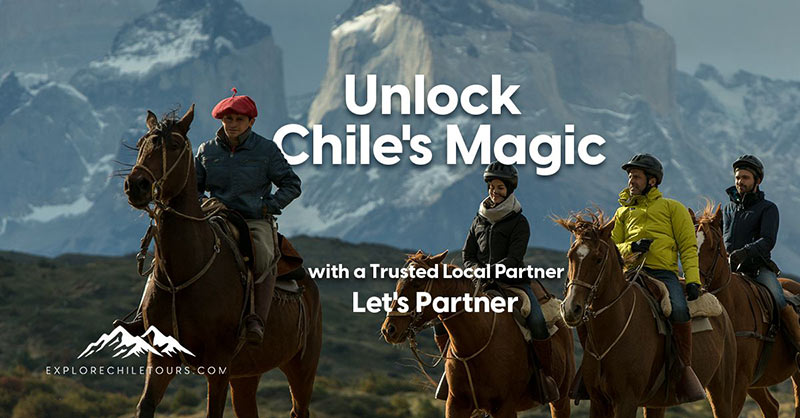Discover the magic of Patagonia! Imagine a place where nature displays its maximum splendor, where…

Inter Lakes Bicycle Journey through the South of Chile
This beautiful bicycle journey starts at the beginning of northern Patagonia.
The Panguipulli Inter Lakes journey is world famous for its natural pristine beauty, local culture, the warmth of its people, and gastronomy. During the adventure, you will bike through numerous picturesque towns such as Coñaripe, Liquiñe, Choshuenco, Neltume, Puerto Fuy and the communal capital, Panguipulli. The 7 lakes are nourished by the mystical Andes Mountain range and Lake Lacar in Argentina. The majority of the lakes are of glacial and volcanic origin. The 7 lakes are made up of Calafquén, Pullinque and Pellaifa, followed by the eastern sector of the Andes Mountain range, Lake Neltume and Pirehueico, central and southern areas of lakes Panguipulli and Riñihue. Navigating these lakes is stunning, filled with beauty. The scenery is spectacular.
Beginning and ending options:
Driving:
Santiago – Cunco (737Km, 8 hours)
Pargua – Santiago (1087 Km, 11h30min)
Flights:
Santiago – Temuco (1h25mins)
Temuco – Cunco (58.5 Km, 1 hour driving)
Pargua – Temuco (171 Km, 2h10mins driving)
Temuco – Santiago (1h25mins flight)


Day 1: Cunco – Hualafquen National Reserve – 90 km
Cunco is located 56 kilometers from the city of Temuco and has various touristic attractions. The area is filled with history that dates back to colonization, Chilean railways, as well as the culture of the Mapuche people. During your journey you will be biking past the famous Colico and Caburgua lakes until you arrive to the Hualafquen National Reserve Park. Hualafquen National Park is composed of extensive forests of araucarias and lenga trees. There is a varied fauna, including pumas, chilla and culpeo foxes, pudúes, cipos, peucos, quiques, chingues and monitos del monte, one of the three species of marsupials that exist in Chile.
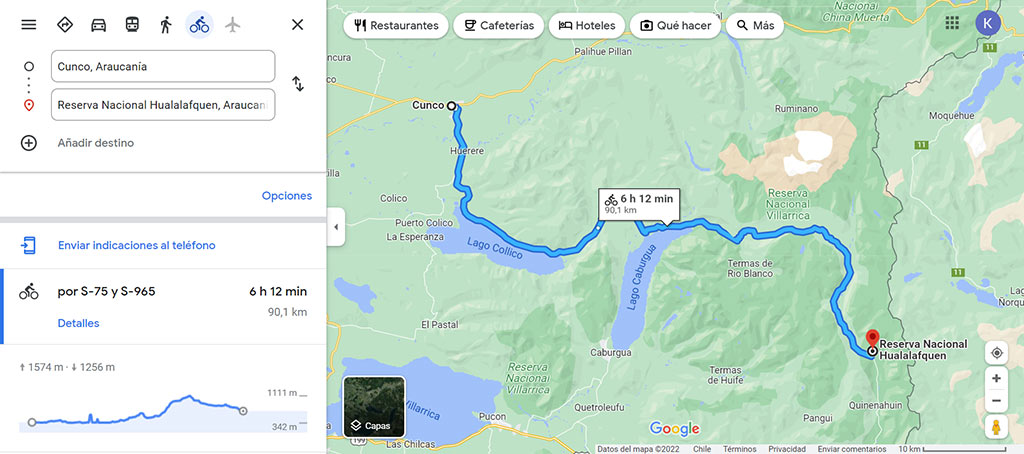
Day 2: Reserva Nacional Hualafquen – LicanRay – 115 km
As your adventure continues, you will bike by Lake Villarrica which is renowned for its spectacular panoramic views, beaches, fields and mountains until you reach LicanRay. In the Mapudungun language, LicanRay means “flor de roca” or “rock flower”. LincanRay is a gem due to the fact that it has never lost its slow pace of life, serenity, and local customs in spite of the passage of time.

Day 3: LicanRay – Cañripe – Puerto Fuy – 73 km
Cañripe has many adventure-type and touristic activities such as scientific, geological and other types of tourism. On the road that connects Cañripe with LicánRay, you can find the Mapuche Fort that has local gastronomy and cultural representations. Puerto Fuy is known for its scenic beauty characterized by its lake edge, views of the Mocho Choshuenco volcanic complex and the presence of snow during the winter. During the summer, the Puerto Fuy Customs Fair offers a wide variety of cuisine, craft beer, and local handcrafts.

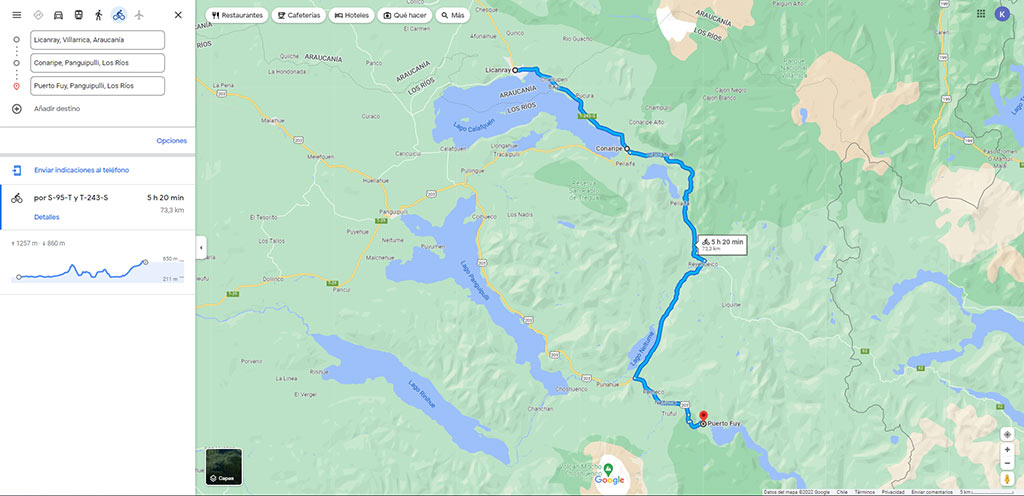
Day 4: Puerto Fuy – Los Lagos – 120 km
As you travel away from Puerto Fuy heading toward Los Lagos, you will be biking along lake Panguipulli. Panguipulli offers exquisite flavors from their local gastronomy which is part of the socio-cultural development of the Mapuche economy within this territory.

Day 5: Los Lagos- Llifen- Lagos Ranco – 118 km
The exuberant beauty found in Llifén creates a deep connection with nature and the environment. You will be able to appreciate the Huequecura hill imposing in the background providing spectacular and dreamlike allure. In addition to the paradisiacal landscapes, the town in known for its people’s warmth and hospitality towards tourists.

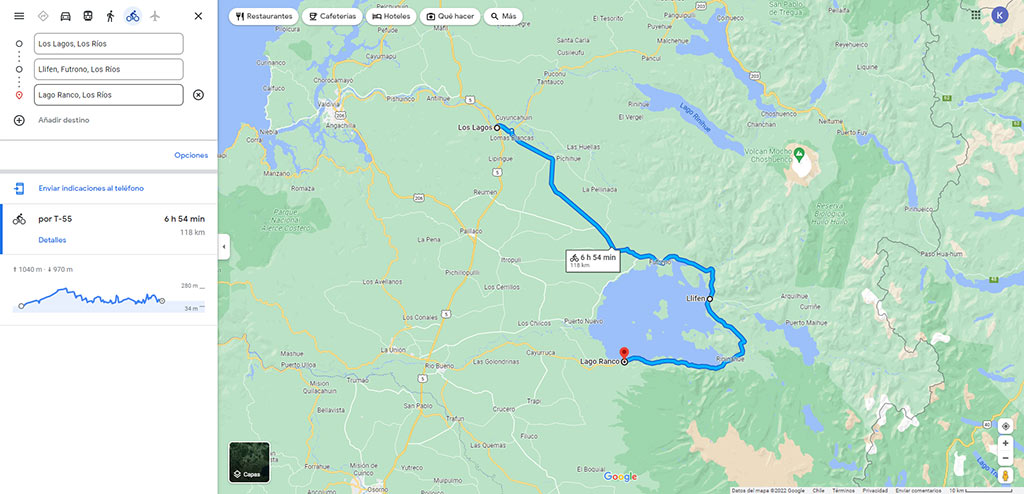
Day 6: Lago Ranco – Termas de Puyehue – 93 km
Lago Ranco is the third largest lake in Chile (442 km2) and one of the most gorgeous lakes in the south of Chile. The lake is surrounded by a riverside road and is the home to 30 indigenous communities that live on its banks and islands. The famous border crossing with Argentina was the protagonist to Pablo Neruda’s escape to Argentina in 1949 which was later written in his memories “Confieso que he vidido.”


Day 7: Termas de Puyehue – Ensenada, Puerto Varas, Los Lagos – 107 km
The hotel Termas de Puyehue is a historic hotel dating back to 1937. It is a great resting point with natural hot springs that have healing properties. Surrounded by the allure and beauty of the Puyehue national park, the hotel offers various outdoor activities, a swimming pool, spa, and excursions throughout the park. The natural hot springs of Puyehue will be sure to rejuvenate and fill you with energy to continue the rest of your biking adventure.

Day 8: Ensenada, Puerto Varas – Los Lagos pargua transbordador – 135 km
Ensenada offers a unique natural setting on the shores of lake LLanquihue, with a view of the three majestic, Osorno, Calbuco, and Puntiagudo volcanoes. Between these three volcanoes is the remarkable Rosales National Park.


Day 9: Los Lagos Pargua Transbordador – Castro -106 km
Los Lagos Pargua is the embarkation point for all visitors travelling to Chiloé island. The ferry from Los lagos Pargua to Castro, Chiloe is about 30 mins. You will be navigating the Chacao, considered by many biologists as the gateway to the world’s past. Upon arrival you will have access to the Chiloe National Park. The park is one of the few forested areas that preserves the primitive character of the flora and of the fauna. The humid and temperate climate of the archipelago allows the existence of the evergreen forest, made up of olivillos, coigües, myrtles and larches. The fauna of the place includes the chilote fox, sea lion, sea otter, pudú, and Patagonian woodpecker.
Chiloe island is a land of myths, legends, traditions, and unparalleled gastronomy. You will discover the colorful stilt houses built on water as well as 16 colorful wooden churches that were declared World Heritage Sites by UNESCO. Chiloe is a unique island with an unparalleled history.


Day 10: Castro-Quellón – 85 km
Castro is the provincial capital of Chiloé. Here you can observe the beautiful typical architecture as well as its impressive natural beauty. From Castro, it is possible to visit the San Francisco Church -World Heritage Site- and also the stilt houses and the craft market. The bike journey continues through the whole island heading south to Quellón. Quellón is one of the most active piers in the areas and is located at the end of Route 5. You will reach milestone zero which is the beginning or end of the Pan-American highway that unites Alaska to Patagonia.


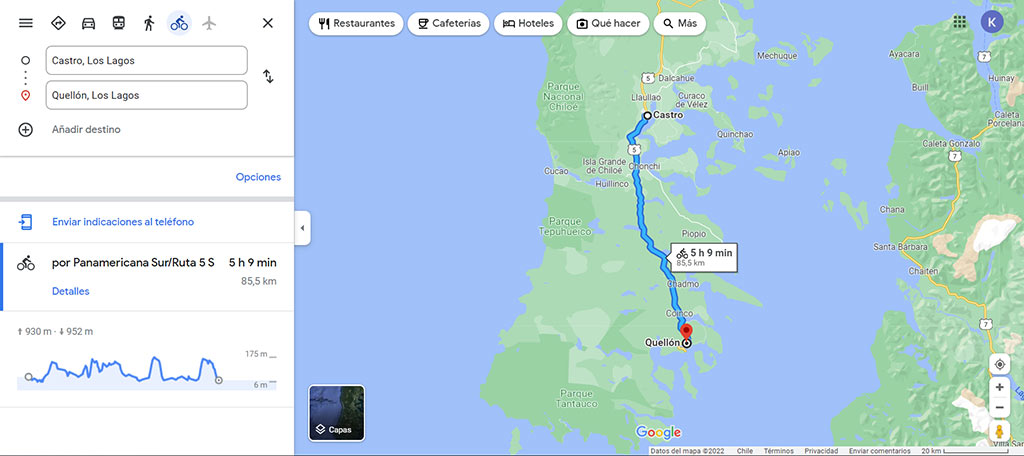
Includes:
- Private guided Bike tour in Southern Chile’s Lake Area (Nothern Patagonia)
- First Aid Car Driver during the trip
- All Hotel reservations (Breakfast included)
- Essential Bicycle Maintenance
- Bicycle spare parts
- Snacks and water
- Photos and 4k 360 degrees videos of the trip
- Closing ceremony “Curanto al Hoyo” (Traditional Chiloé meal which consists of seafood, meat, potatoes and vegetables and is traditionally prepared in a hole, which is dug in the ground. The food is cooked over heated stones in an earthen pit with “nalca” leaves. Participating in a “Curanto” is a unique mystical and folkloric experience found in the south of Chile.
- 1,042 + Kilometers of an epic biking adventure in one of Chiles most beautiful and pristine regions!
*Lunches and dinners are not included and must be paid directly at the local establishment
***Subject to availability***


